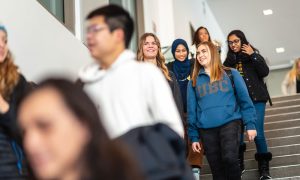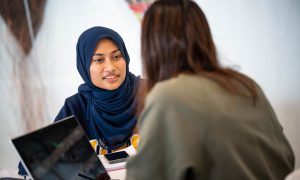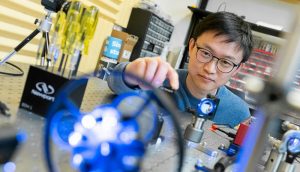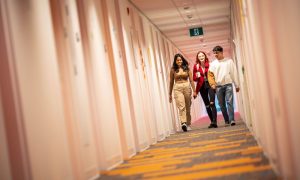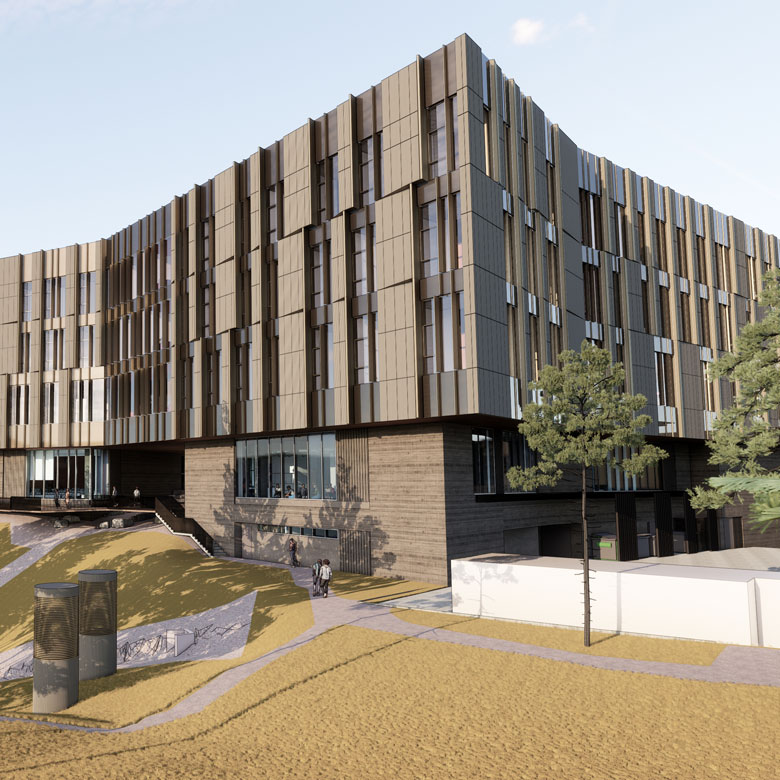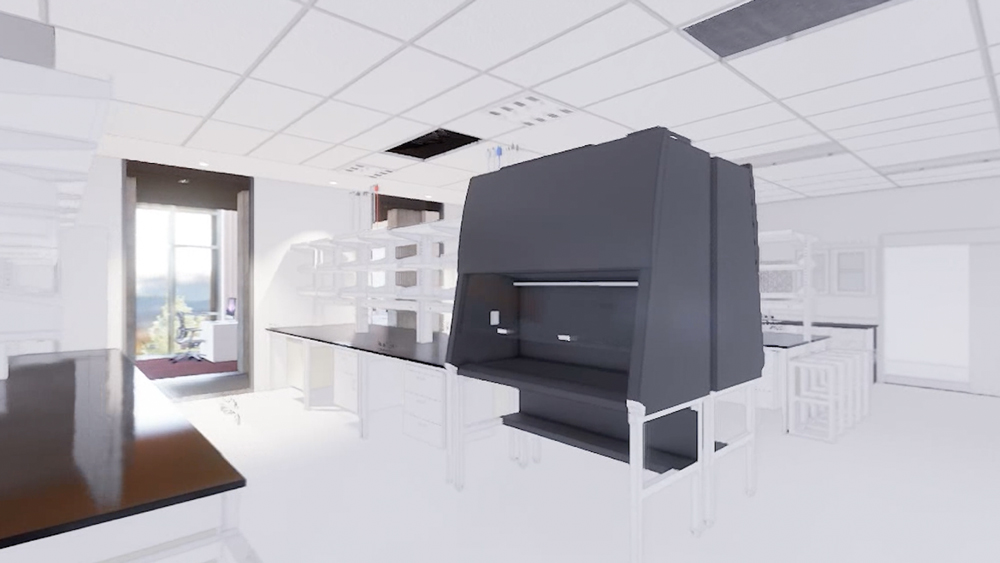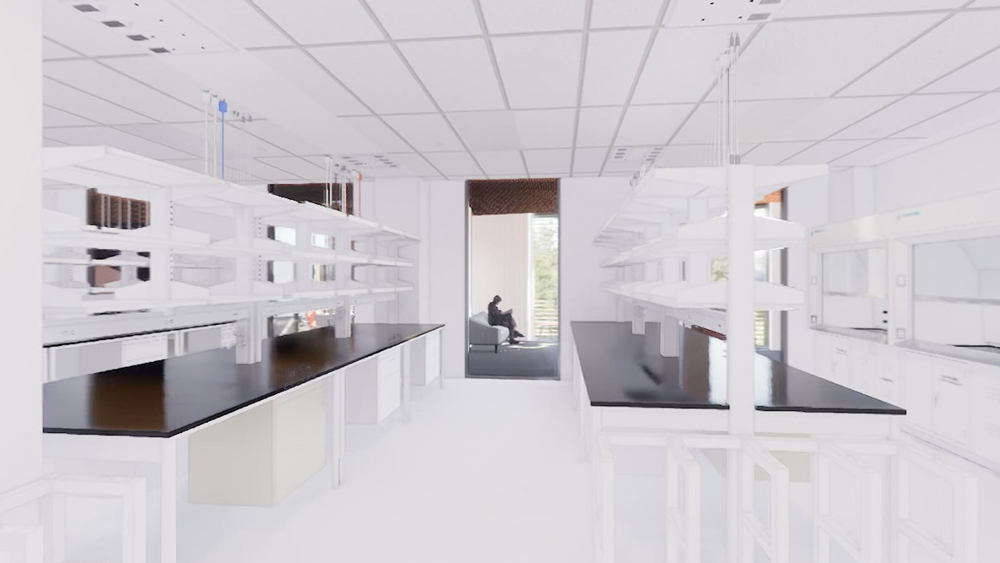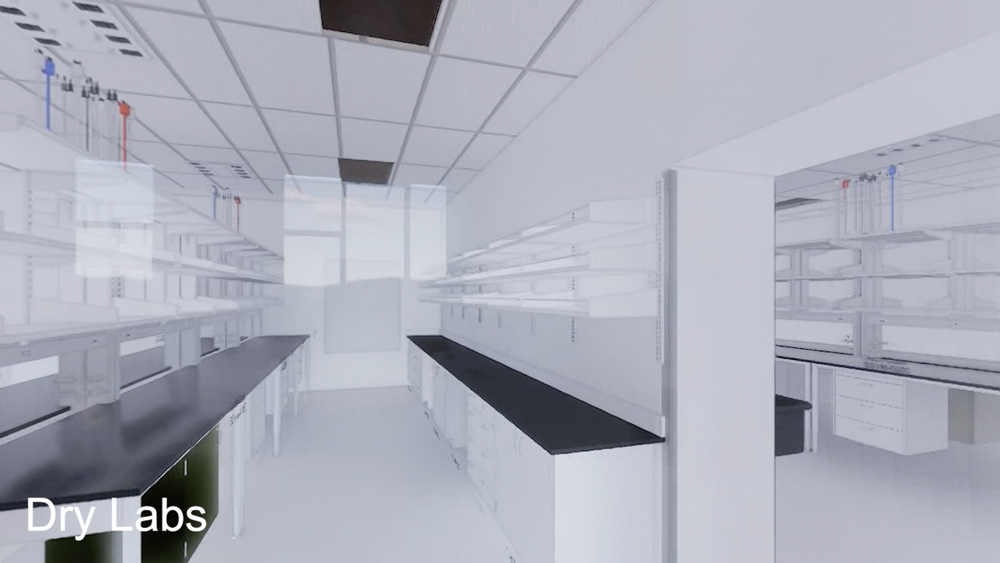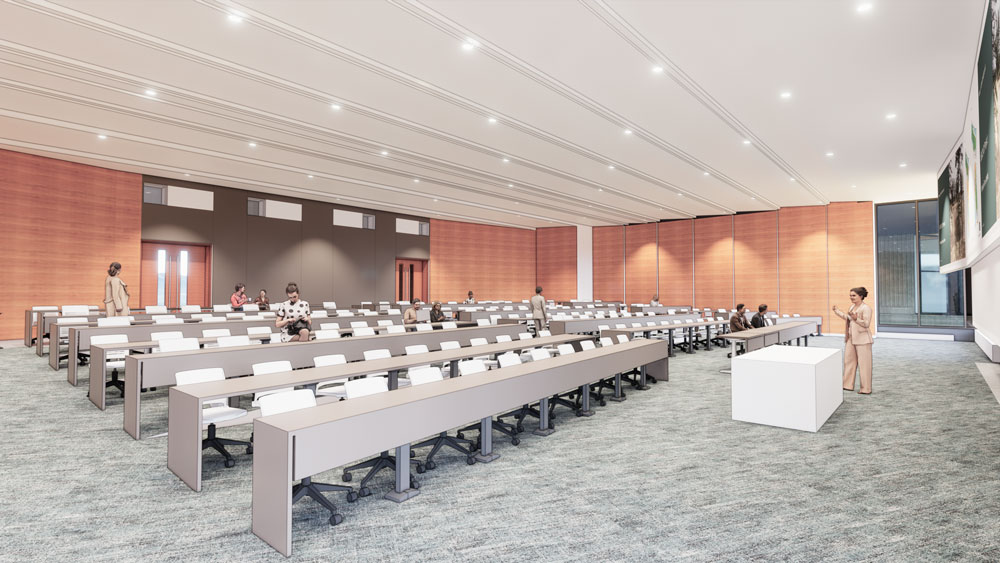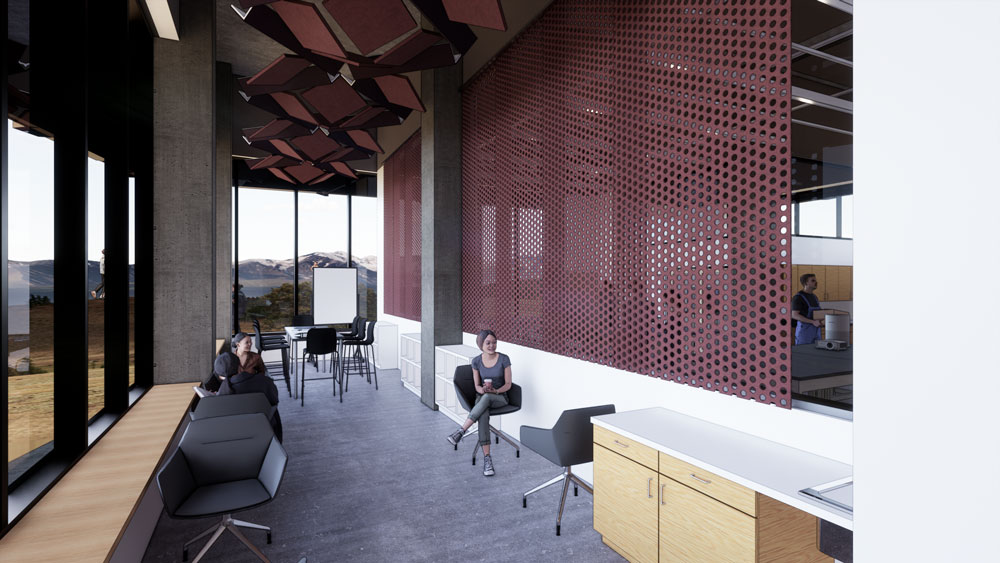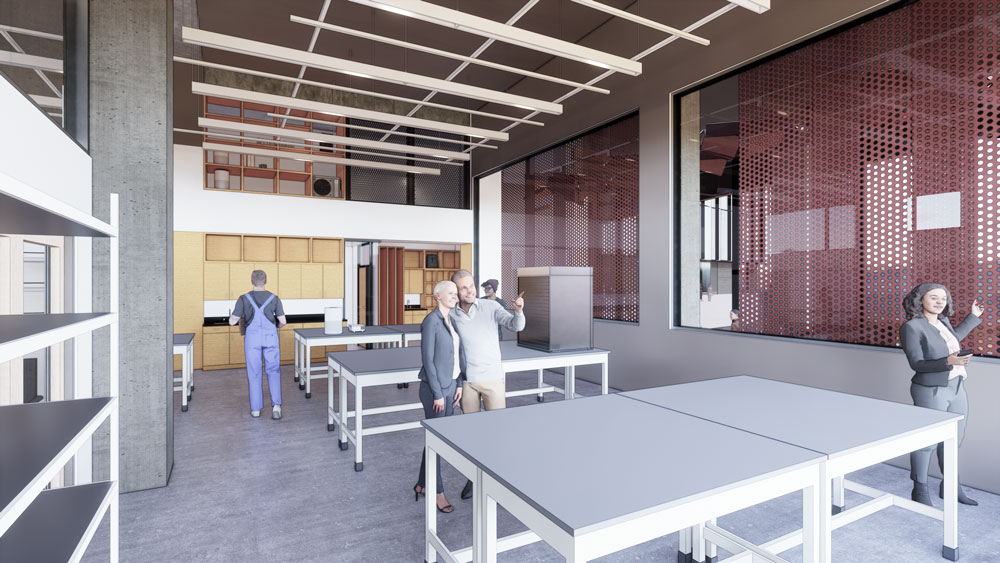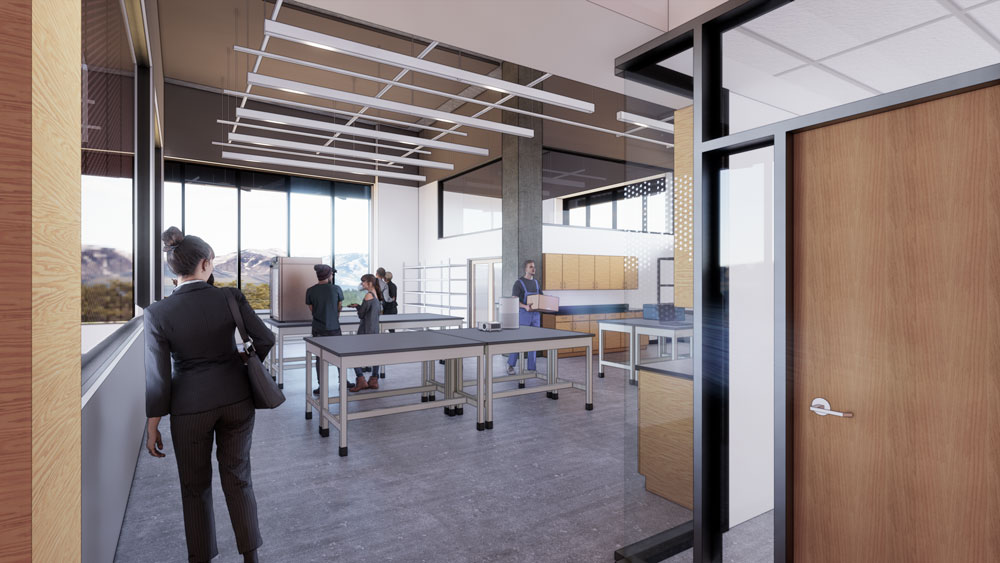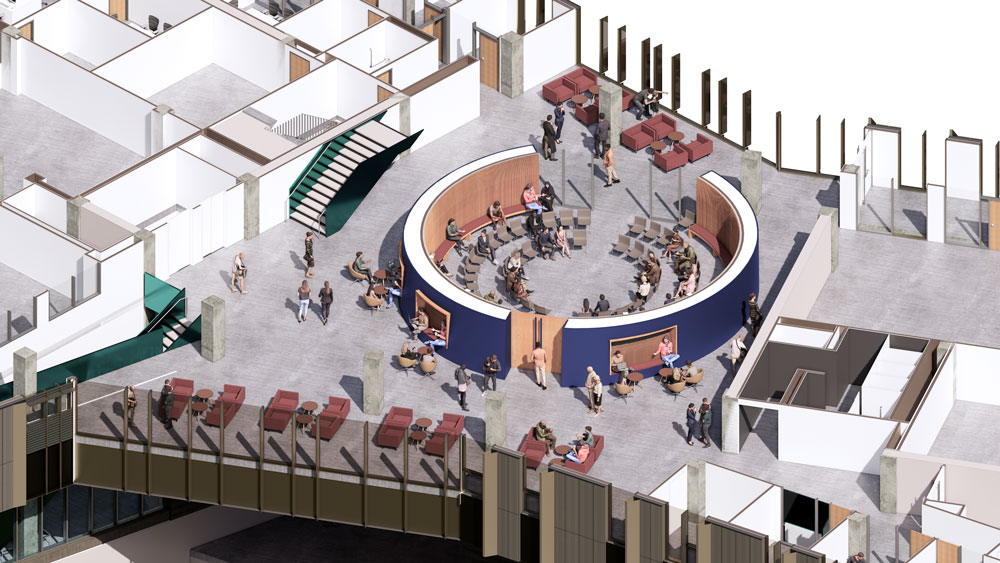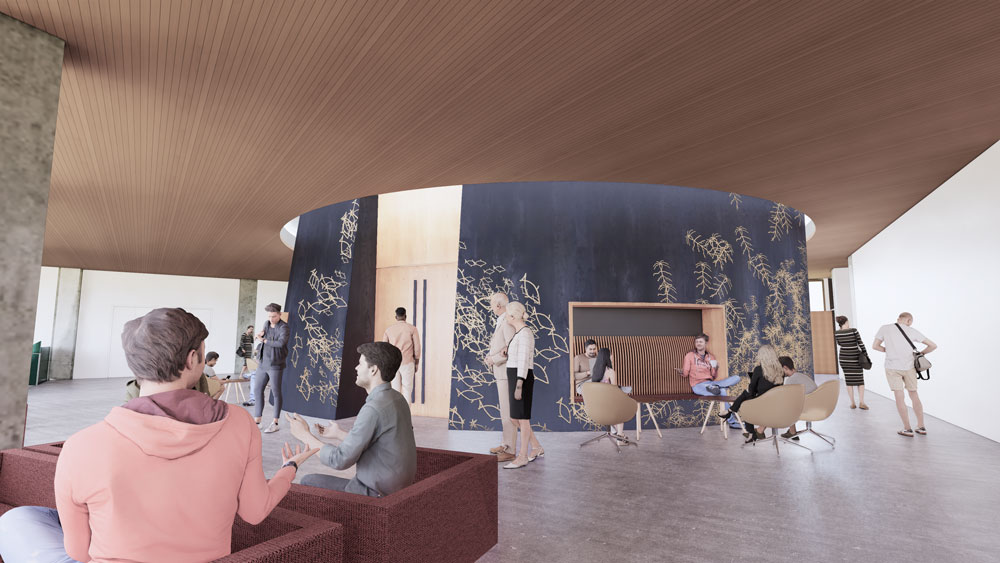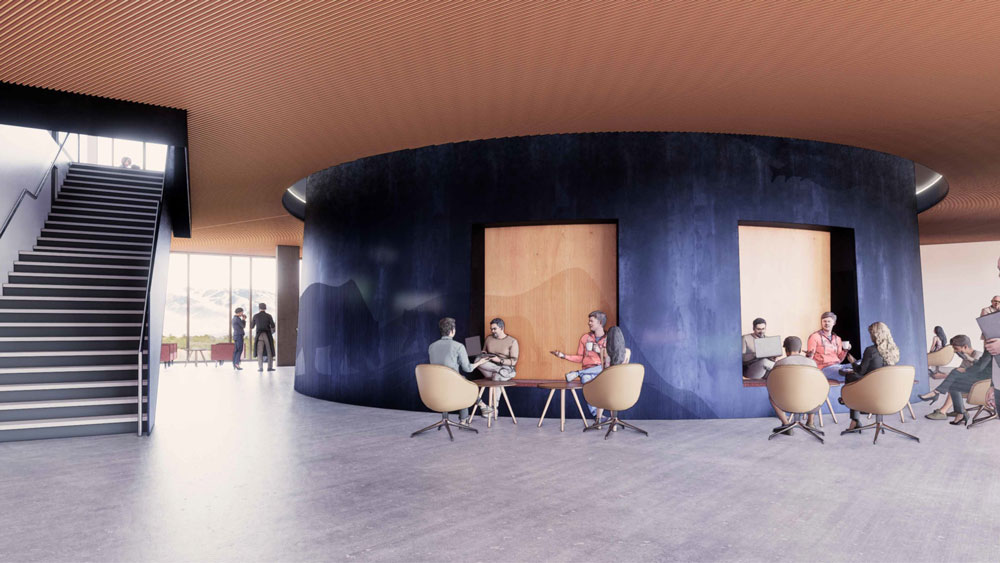In January 2023, the En’owkin Centre generously gifted UBC Okanagan with an Nsyilxcn name for the building currently under construction south of the Engineering, Management and Education building (EME). Once open, x̌əl sic snpax̌nwixʷtn will bring together students, faculty and staff for learning, engagement and collaboration.
What does the name mean?
snpax̌nwixʷtn
A place where people work together to enlighten and inform each other
Pronunciation (voiced by kəɬk̓əmpic̓aʔ – Elder Rose Caldwell)
UBC Okanagan is incredibly grateful for this generous gift from our Syilx Okanagan partners.
Culture of Collaboration
Set to open in March 2026, x̌əl sic snpax̌nwixʷtn will bring together scholars and students in a new and innovative way. x̌əl sic snpax̌nwixʷtn will be uniquely organized into neighbourhoods shared by teams of interdisciplinary researchers from across UBC Okanagan’s entire research spectrum.
The building will support these teams as they research and help solve complex societal challenges from multiple perspectives, leveraging the expertise already assembled on campus and helping recruit new talent to meet the promise of an engaged university.

Rendering courtesy of HCMA and KieranTimberlake.
A Space for Engagement
Interdisciplinary work is flourishing on campus. This building provides a platform that enables team-based approaches to solving complex problems, and supports collaborations with Indigenous partners, community members and industry.
x̌əl sic snpax̌nwixʷtn will symbolize and cultivate UBC Okanagan’s substantive commitment to Truth and Reconciliation and partnerships with the Syilx Okanagan Nation, and will be home to our Interior Salish language fluency programs and the Centre for Contemporary Interior Salishan Studies. Indigeneity has been a guiding principle for this building at every stage of planning and design, with a vision to incorporate Syilx knowledge and values, as appropriate, across research and learning programs in the building.
>400
Scholars and students collaborating daily in research
>500
Seats for teaching and learning in classrooms and the new lecture hall
92%
Expected reduction in carbon emissions (compared to LEED baseline buildings)
Teams working in x̌əl sic snpax̌nwixʷtn
x̌əl sic snpax̌nwixʷtn will be a home for curious and collaborative interdisciplinary research champions, and those who are ambassadors of community engagement and inclusive and progressive change.
The following interdisciplinary research teams will be working in the building upon its completion:
A unique space where a diverse community of biophysical scientists, engineers, clinicians and trainees work together to create immunotherapies and diagnostics that are locally relevant and globally significant.
With a founding mission of gaining insight into the complexity of the immune system by creating transformative technologies that lead to medical interventions.
A place where people, ideas and technologies converge to learn from each other, be connected to the purpose of the x̌əl sic snpax̌nwixʷtn, and achieve breakthrough for human health.
Academic Lead: Isaac Li
Team Members: Robert Godin, Frederic Menard, Wesley Zandberg, Thuy Dang, Luca Piantanida, William Hughes, Jennifer Frattolin, Emmanuel Osei, Mark Rheault, Perry Howard, Mike Deyholos, Jonathan Holzman
Bringing together researchers from education, engineering, science and social sciences in a dynamic and inclusive environment. Focused on local climate mitigation and adaptation research defined by five pillars -transportation, building, environment, health and community.
Using innovative techniques such augmented (AR) and virtual reality (VR) to build models. Data will inform behavioral, machine learning, agent-based simulation, policy analysis and community engagement.
Academic Co-Leads: Mahmudur Fatmi, Qian Chen, Mohammad Khalad Hasan
Team Members: Jahangir Hossain, Kasun Hewage, Shahria Alam, Suliman Gargoum, Amir Ardestani-Jaafari, Jon Corbett, Zheng Liu, Andrea Craig, Babak Tosarkani, Robert Campbell, Sumer Seiki, John Janmaat
Leading training and research that supports the recovery of ecosystems and communities that depend on healthy lands, water and air.
Bridging social and natural sciences, Western and Indigenous ways of knowing, academic and professional research and field laboratory studies.
Creating and transferring knowledge that increases understanding of how people negatively affect the environment and co-developing new pathways that support the recovery of nature.
Academic Co-Leads: Adam Ford, Jason Pither
Team Members: Lael Parrott, Miranda Hart, Michael Russello, Michael Noonan, Rebecca Tyson, Tal Avgar, Laura Grieneisen, Chase Mason
Bringing together an interdisciplinary team of research who share interests in communication and language as connected to social and mental health.
Combining expertise in linguistics of Indigenous languages, anthropology, and psychology with the aim to uncover how children and adults learn language, how people build rapport and connection through language, how guilty and innocent people use language and how language and communication contribute to well-being, effective social interactions, social connection and relationship development.
Academic Co-Leads: Diana Carter, John Lyon, Elena Nicoladis
Team Members: Monica Good, Lauren Human, Francis Langevin, Jessica Lougheed, Christine Schreyer, Leanne ten Brinke, Shannon Ward, Michael Woodworth
Addressing the contemporary challenges of climate change, ecological destruction and the legacies of colonialism including loss of linguistic diversity.
Focusing the diverse areas of Indigenous knowledge held by UBCO faculty and allied scholars. Articulation of the new IK IGS Theme, preparing the next generation of scholars to help address contemporary challenges, providing opportunities for connections for Indigenous graduates to link into and undertake degrees relevant to their communities.
Academic Leads: Shawn Wilson, Alanaise Ferguson
Team Members: Kerrie Charnley, Monica Good, Peter Hutchinson, Gabrielle Legault, Ben Ramirez, Lisa Tobber
A hub for data-based research and training activities with global reach, leveraging AiMS, BIRS, PIMS and RDC.
This research incubator with applications in health and environment will build new and sustained research collaboration opportunities; hosting groups of leading researchers in mathematical and data sciences, as well as capacity building through workshops and summer schools.
Academic Leads: W. John Braun, Andrew Jirasek
Team Members: Heinz Bauschke, Charmaine Dean, Rebecca Feldman, Kevin Hanna, Pourang Irani, Robert Deardon, Malabika Pramanik, Mohamed Shehata, Xiaoping Shi, Ozgur Yilmaz, Andrea Craig, Rebecca Tyson, John Thompson, Michael Noonan, Mark Lewis, Jeffrey Andrews, Gino DiLabio, Lengyi Han, Fatemeh Fard, Rebecca Feldman, Christina Haston, Irene Vrbik, Rasika Rajapakshe, Nathan Becker, Thor Bjarnason, Michelle Hilts, Alex Hill, Zheng Liu, Susan Murch
Building on existing relationships with Syilx, Secwépemc, NłeɁkepmx, Hawaiian, and Occitan partner organizations and communities to foster revitalization of endangered languages and cultural resurgence through land-based eco-cultural practices. Partnering with the Indigenous Art Intensive, the En’owkin Centre, and ICER to create a more equitable, diverse and inclusive research and training environment while strengthening UBC Okanagan’s relationship to the Syilx Okanagan Nation and the Okanagan Nation Alliance, fulfilling UNC’s ISP and UBCO’s commitment to TRC.
Academic Co-Leads: Bill Cohen, Manulani Aluli Meyer, Virginie Magnat
Team Members: Tania Willard, Shawn Wilson, Karen Ragoonaden, Tracey Bonneau, Vicki Kelly, Evan Adams, Tina Fraser, Emma Bigé, Nathalie Gauthard, Konstantinos Thomaidis, Bryony Onuciul
Drawing on expertise from the humanities, arts, social sciences and sciences; focused on place-based, community-engaged, practice led approaches, as well as antiracist, feminist, anticolonial and inclusive frameworks to address “wicked problems” that have no easy scientific -technological solutions.
With a focus on pedagogical research, oriented in a spirit of collaboration and responsibility, including two new campus research training initiatives (IGS Sustainability and BSust).
Academic Co-Leads: Astrida Neimanis, Anita Girvan, Natalie Forssman
Team Members: Rebecca Tyson, Aleksandra Dulic, Greg Garrard, Denise Kenney, Nikhita Obeegado, Nathan Pelletier, Vikas Menghwani, Adeniyi Asiyanbi, Onyx Sloan Morgan, Tim Paulson
Conducting research in watershed communities to assess linkages and interactions among critical processes and values (i.e. timber, biodiversity, Indigenous values, aquatic functions and water) using an interdisciplinary approach.
Leveraging collaborations with local communities, First Nations, governments and others in advancing watershed ecosystem science and governance innovations that are fully inclusive of Indigenous rights, knowledge and values.
Academic Leads: Adam Wei, John Wagner
Team Members: Jeanette Armstrong, Lael Parrott, Sheena Spencer, Alyse Kiesser
Building Features
Courtesy of HCMA.
Quick Facts
14,185 square metres of space to support interdisciplinary teaching, learning, research and community engagement.
A footprint that integrates with the surrounding landscape and a subtle exterior facade influenced by the grasses, landscape and hues of the Okanagan valley.
Designed to LEED Gold certification, a globally recognized symbol of sustainability achievement and leadership.
Located immediately south of the Engineering, Management and Education (EME) building, and north of parking Lot J.
Research and knowledge creation spaces
- 366 open workstations for graduate students, postdoctoral fellows, research trainees and staff
- 68 offices for faculty researchers and visiting scholars and Elders
- 23 open wet labs with shared support and infrastructure rooms (e.g., fume hoods, tissue culture rooms, equipment rooms, etc.)
- 16 flexible research dry labs (that can be used as art studios, performance spaces, data acquisition/visualization spaces, etc.)
- 2 shared research facilities (317 square metres): Imaging and Metabolomics
Renderings courtesy of HCMA and KieranTimberlake.
Learning and engagement spaces
- A 200-seat active learning lecture hall
- 18 multipurpose meeting and conference rooms with 4–50 seats
- 8 classrooms with 16–40 seats
- 3 lounges with room for 20–70 people
- 2 language labs for Interior Salish language fluency programs
- Informal learning spaces for up to 64 people
- A new makerspace with adjacent design-think and finishing spaces
Renderings courtesy of HCMA and KieranTimberlake.
Gathering space
The second level of the building will contain a circular gathering space for up to 100, the design of which was guided by engagement with the En’owkin Centre.
The circular room will support a space for dialogue and conversation, while honouring and strengthening the foundational partnership between the campus and the Okanagan Nation Alliance, enabling respectful and reciprocal collaborations with the community.
Renderings courtesy of HCMA and KieranTimberlake.
Explore floorplans
See the distribution and adjacencies of the different types of spaces in the building: x̌əl sic snpax̌nwixʷtn floorplans (PDF)
x̌əl sic snpax̌nwixʷtn Leadership
Natalie Rodriguez
Director, Interdisciplinarity and Operations x̌əl sic snpax̌nwixʷtn
Karis Shearer
Academic Co-lead, VPRI
Peter Simpson
Academic Co-lead, Provost’s Office
Michael Persinger
Associate Director, Facilities Planning, Infrastructure Development
Mathew Hall
Facilities Planner, Facilities Planning, Infrastructure Development
Construction
Construction began in early 2023. Occupancy is expected in March 2026.
